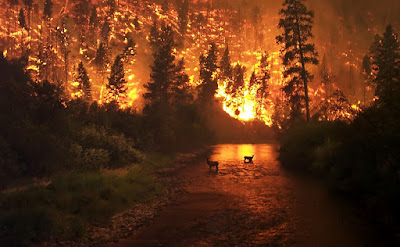Wildfire Preparedness Tips
 |
Factors that contribute to disastrous wildfires include:
1. Uneven amounts of rain
from year to year – during a rainy year, the understory vegetation grows
dense. If the following year is a dry year, the dense vegetation dies and
become fuel for fires.
2. Freezing weather
will kill the vegetation turning into fire fuel.
3. Urban growth –
building communities and houses in fire prone areas increases the available
fuel
4. Wind – dry winds
and/or fast winds help spread wildfires
5. Excessive fuel
– reduced funding to the Forest Service has hindered their ability to maintain
the amount of dense under-story growth in forests. Current policy prevents the use
of prescribed burns in many areas.
(Write
your Congressional Representative to advocate for more
prescribed/controlled burns.)
6. Lighting –
natural phenomenon that is unavoidable – however, with reduced fuel fires will
burn less hot and do less damage.
FUEL…FUEL…FUEL…Fires
need fuel (something to burn)
Reduced fuel = less intense wildfires
Take Action to
Protect Your Home against Wildfires
If you rent your home
or live in an apartment, speak with your property manager and ask them what
steps they have taken to create a fire retardant building and landscape. If you own your home / property take the following precautions
to create a fire retardant building and landscape.
1. Fire Zone (reduced-fuel zone) – 200 foot zone around
structures or along property line. In this area, plant low growing, drought
resistant deep-rooted ground cover. If your property is small and you cannot create a 200 foot
zone then at a minimum maintain fire lanes around your house and outbuilding.
2. Fire Lane – on at least 2-sides of your house, keep an
area clear of shrubs, trees, and obstacles wide enough for a fire truck. It is important to provide access to your
house big enough for a fire truck.
3. Access to water:
- Install a water hydrant. If possible, use a gravity feed from a pond or pool.
- Pond, pool, hot tubs provide a store of water
- Pump – keep your pump well-maintained – it is preferable to use gas or propane to run the pump that way it will work in the case of an electrical power outage.
4. Building materials:
- Use non-flammable siding
- Use non-combustible roofing materials
Fire-mindful
Landscape Design and Maintenance
1. Clean all vegetation off roof and gutters
2. Regularly clean-up leaves – add to compost
3. Prune vegetation
4. Cut out weak or diseased trees
5. Clear out / cut back overhanging branches that hand over
building, driveway, fire zone and fire
lane (branches should be 15 – 20 feet
from buildings)
6. Thin crowns of trees – cut out all dead branches – clear branches
20 feet from the ground
7. Get rid of stumps
8. Keep vegetation under trees low – plant ground covers and
low shrubs
9. Clear area around house:
- Keep no major plants or trees within 30 – 50 feet of buildings
- Plant just enough shrubbery to stabilize ground or slopes
- Alternatively use perennials, wildflowers, and native plants to stabilize ground
10. Plant vegetation in islands separated by pavers or grass:
- 300 – 500 feet apart
- Plant shrubs as far apart as the height
11. Water regularly – maintain plant vitality
Highly Flammable
Plants (avoid if possible)
Fir
|
Chamise (Adenostoma
fasaculatum)
|
Acacia
|
Manzanita
|
Cedar
|
Pampas grass
|
Cypress
|
Scotch broom
|
California buckwheat
|
Gum
|
Palms
|
Juniper
|
Spruce
|
Pine
|
Laurel sumac (Rhus laurina)
& California laurel
|
Rosemary
|
Yew
|
Arborvitae
|
Stay Informed about
Current Wildfire
- USDA Forest Service Active Fire Mapping Program
- National Wildfire Coordinating Group Interagency All-Risk Incident Information Management System
- National Interagency Fire Center
Reference: photo credit - USFS



Comments
Post a Comment